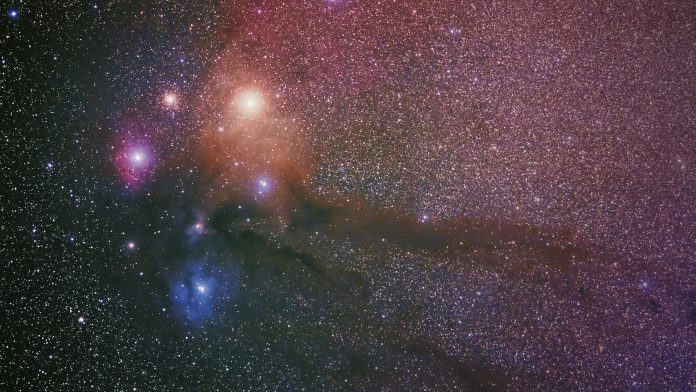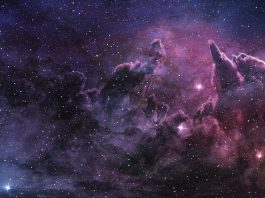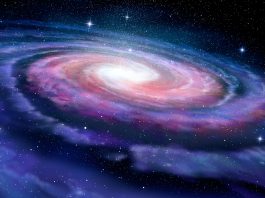A novel investigation has identified that a region of star formation – located in the Ophiuchus constellation – may potentially illustrate how our solar system came into existence.
The Ophiuchus constellation study, conducted by an international team of researchers, provides unprecedented insights into the birth conditions of our solar system, such as how it became enriched with short-lived radioactive elements.
The study is published in Nature Astronomy.
Ophiuchus constellation enrichment
For around 50 years, there has been evidence of this enrichment process, which was discovered by scientists when studying the specific mineral compositions of meteorites. They ascertained that they were the pristine remnants of infant stages of the solar system and comprised the decay products of short-lived radionuclides. These are radioactive elements that may have been exerted into the blossoming solar system by a proximate supernova (an exploding star) or by powerful stellar winds from a massive classification of star called a Wolf-Rayet star.
To perform their investigation, the astronomers carried out multi-wavelength observations of the star-forming region of the Ophiuchus constellation, obtaining infrared data that uncovered the interactions between star-forming gas and radionuclides produced in infant star clusters. Their observations signify that supernovas in these star clusters are the most probable source of short-lived radionuclides in the star-forming clouds.
Douglas N. C. Lin, a professor emeritus of astronomy and astrophysics at UC Santa Cruz and co-author of the study, said: “Our solar system was most likely formed in a giant molecular cloud together with a young stellar cluster, and one or more supernova events from some massive stars in this cluster contaminated the gas which turned into the Sun and its planetary system.
“Although this scenario has been suggested in the past, the strength of this paper is to use multi-wavelength observations and a sophisticated statistical analysis to deduce a quantitative measurement of the model’s likelihood.”
John Forbes, the first author of the research from the Flatiron Institute’s Center for Computational Astrophysics, said: “Data from space-based gamma-ray telescopes enable the detection of gamma rays emitted by the short-lived radionuclide aluminium-26. These are challenging observations. We can only convincingly detect it in two star-forming regions, and the best data are from the Ophiuchus complex.”
Examining the enigmatic aluminium-26
The cloud complex of the Ophiuchus constellation contains various dense protostellar cores in different phases of star formation and protoplanetary disc development. This represents the earliest formation stages of a planetary system. The researchers combined imaging data ranging from millimetres to gamma rays, enabling them to visualise a flow of aluminium-26 from a close-by star cluster in the Ophiuchus star-forming region.
Forbes said: “The enrichment process we see in Ophiuchus is consistent with what happened during the formation of the solar system 5 billion years ago. Once we saw this nice example of how the process might happen, we set about trying to model the nearby star cluster that produced the radionuclides we see today in gamma rays.”
Subsequently, Forbes created an innovative model that accounts for every massive star that could have potentially existed in this region, including its age, mass, and the possibility of it resulting in a supernova. It also incorporated the potential yields of aluminium-26 from supernovas and stellar winds, all of which allowed him to estimate the likelihoods of varying scenarios to produce the aluminium-26 displayed today.
“We now have enough information to say that there is a 59% chance it is due to supernovas and a 68% chance that it’s from multiple sources and not just one supernova,” Forbes commented.
Lin said: “This type of statistical analysis assigns probabilities to scenarios that astronomers have been debating for the past 50 years. This is the new direction for astronomy, to quantify the likelihood.”
The novel investigation highlights that the number of short-lived radionuclides can vary dramatically in forming star systems.
“Many new star systems will be born with aluminium-26 abundances in line with our solar system, but the variation is huge – several orders of magnitude,” Forbes said. “This matters for the early evolution of planetary systems since aluminium-26 is the main early heating source. More aluminium-26 probably means drier planets.”
João Alves, a co-author of the research, obtained the infrared data as part of the European Southern Observatory’s VISION survey of nearby stellar nurseries by employing the VISTA telescope in Chile. This allowed the astronomers to observe the star-forming complex by looking through the dusty clouds that envelop it.
He said: “There is nothing special about Ophiuchus as a star formation region. It is just a typical configuration of gas and young massive stars, so our results should be representative of the enrichment of short-lived radioactive elements in star and planet formation across the Milky Way.”









